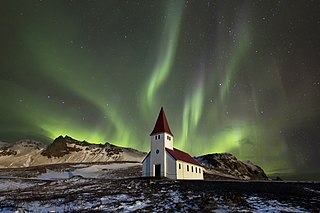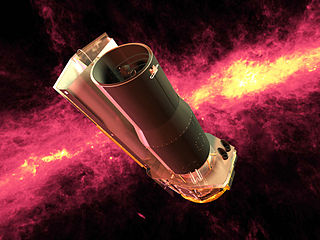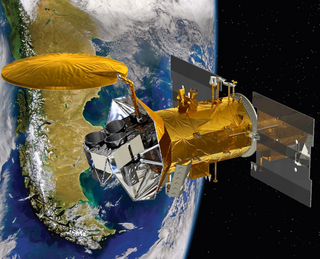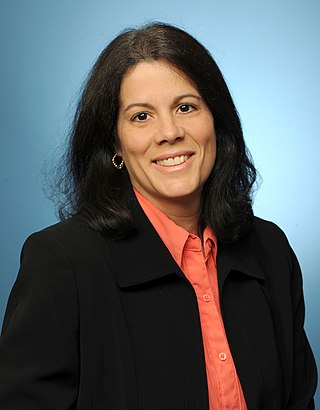
An aurora , also commonly known as polar lights, northern lights, or southern lights, is a natural light display in Earth's sky, predominantly seen in high-latitude regions. Auroras display dynamic patterns of brilliant lights that appear as curtains, rays, spirals, or dynamic flickers covering the entire sky.

The Spitzer Space Telescope, formerly the Space Infrared Telescope Facility (SIRTF), was an infrared space telescope launched in 2003. Operations ended on 30 January 2020. Spitzer was the third space telescope dedicated to infrared astronomy, following IRAS (1983) and ISO (1995–1998). It was the first spacecraft to use an Earth-trailing orbit, later used by the Kepler planet-finder.

The Goddard Space Flight Center (GSFC) is a major NASA space research laboratory located approximately 6.5 miles (10.5 km) northeast of Washington, D.C. in Greenbelt, Maryland, United States. Established on May 1, 1959 as NASA's first space flight center, GSFC employs approximately 10,000 civil servants and contractors. Named in recognition of American rocket propulsion pioneer Robert H. Goddard, it is one of ten major NASA field centers. GSFC is partially within the former Goddard census-designated place; it has a Greenbelt mailing address.

Piers John Sellers was a British-American meteorologist, NASA astronaut and Director of the Earth Science Division at NASA/GSFC. He was a veteran of three Space Shuttle missions. Sellers attended Cranbrook School, Cranbrook, Kent, United Kingdom, until 1973, and achieved a bachelor's degree in ecological science from the University of Edinburgh in 1976. In 1981 he gained a doctorate in biometeorology from the University of Leeds. In 2011, Sellers retired from the NASA Astronaut Corps.

The Goddard Institute for Space Studies (GISS) is a laboratory in the Earth Sciences Division of NASA's Goddard Space Flight Center affiliated with the Columbia University Earth Institute. The institute is located at Columbia University in New York City. It was named after Robert H. Goddard, American engineer, professor, physicist and inventor who is credited with creating and building the world's first liquid-fueled rocket.
Melissa G. Trainer, Ph.D. is an American astrobiologist who in 2004 demonstrated empirically that life could have formed on Earth through the interaction of methane, carbon dioxide and ultraviolet light (sunlight). She is currently Assistant Chief for Science, Operations, and Strategic Planning in the Planetary Environments Laboratory at NASA's Goddard Space Flight Center.

Time History of Events and Macroscale Interactions during Substorms (THEMIS) mission began in February 2007 as a constellation of five NASA satellites to study energy releases from Earth's magnetosphere known as substorms, magnetic phenomena that intensify auroras near Earth's poles. The name of the mission is an acronym alluding to the Titan Themis.

Aquarius was a NASA instrument aboard the Argentine SAC-D spacecraft. Its mission was to measure global sea surface salinity to better predict future climate conditions.

Amri Hernández-Pellerano is a Puerto Rican electronics engineer and scientist who designs, builds and tests the electronics that will regulate the solar array power in order to charge the spacecraft battery and distribute power to the different loads or users inside various spacecraft at NASA's Goddard Space Flight Center. She designed the power systems electronics for the Wilkinson Microwave Anisotropy Probe (WMAP) mission. WMAP is a NASA Explorer mission spacecraft which measures the temperature of the cosmic background radiation over the full sky with unprecedented accuracy.

MAVEN is a NASA spacecraft orbiting Mars to study the loss of that planet's atmospheric gases to space, providing insight into the history of the planet's climate and water. The name is an acronym for "Mars Atmosphere and Volatile Evolution" while the word maven also denotes "a person who has special knowledge or experience; an expert". MAVEN was launched on an Atlas V rocket from Cape Canaveral Air Force Station, Florida, on 18 November 2013 UTC and went into orbit around Mars on 22 September 2014 UTC. The mission is the first by NASA to study the Mars atmosphere. The probe is analyzing the planet's upper atmosphere and ionosphere to examine how and at what rate the solar wind is stripping away volatile compounds.

Soil Moisture Active Passive (SMAP) is a NASA environmental monitoring satellite that measures soil moisture across the planet. It is designed to collect a global 'snapshot' of soil moisture every 2 to 3 days. With this frequency, changes from specific storms can be measured while also assessing impacts across seasons of the year. SMAP was launched on 31 January 2015. It was one of the first Earth observation satellites developed by NASA in response to the National Research Council's Decadal Survey.

Global Precipitation Measurement (GPM) is a joint mission between JAXA and NASA as well as other international space agencies to make frequent observations of Earth's precipitation. It is part of NASA's Earth Systematic Missions program and works with a satellite constellation to provide full global coverage. The project provides global precipitation maps to assist researchers in improving the forecasting of extreme events, studying global climate, and adding to current capabilities for using such satellite data to benefit society. GPM builds on the notable successes of the Tropical Rainfall Measuring Mission (TRMM), which was also a joint NASA-JAXA activity.

The Heliophysics Science Division of the Goddard Space Flight Center (NASA) conducts research on the Sun, its extended Solar System environment, and interactions of Earth, other planets, small bodies, and interstellar gas with the heliosphere. Division research also encompasses geospace—Earth's uppermost atmosphere, the ionosphere, and the magnetosphere—and the changing environmental conditions throughout the coupled heliosphere.
UFO sightings in outer space are sightings of unidentified flying objects reported by astronauts while in space that they could not explain at the time. These sightings have been claimed as evidence for alien visits by ufologists.

STEVE is an atmospheric optical phenomenon that appears as a purple and green light ribbon in the sky, named in late 2016 by aurora watchers from Alberta, Canada. According to analysis of satellite data from the European Space Agency's Swarm mission, the phenomenon is caused by a 25 km (16 mi) wide ribbon of hot plasma at an altitude of 450 km (280 mi), with a temperature of 3,000 °C and flowing at a speed of 6 km/s (3.7 mi/s). The phenomenon is not rare, but had not been investigated and described scientifically prior to that time.

Elizabeth MacDonald is a space weather scientist who works at NASA Goddard Space Flight Center. She is a co-investigator on the Helium, Oxygen, Proton, and Electron Spectrometer on the NASA Radiation Belts Storm Probe mission.

Rita M. Sambruna Commander OMRI (Hon) is an Italian-American astrophysicist and is the Deputy Director of the Astrophysics Science Division at National Aeronautics and Space Administration's (NASA) Goddard Space Flight Center. From September 2022 to May 2023, she was the Acting Deputy Director of the Science Exploration Directorate at Goddard. Rita held the Clare Boothe Luce Professorship in Physics and Astronomy at George Mason University in 2000-2005.

The COVID-19 pandemic has affected many scientific and technical institutions globally, resulting in lower productivity in a number of fields and programs. However, the impact of the pandemic has led to the opening of several new research funding lines for government agencies around the world.
John T. Clarke is a professor of astronomy and director of the Center for Space Physics at Boston University. Clarke is best known for his Hubble Space Telescope observations of the aurora on Jupiter and Saturn, as well as over 260 papers in refereed journals, including every planet except Mercury and the interplanetary medium. Clarke's research is focussed on vacuum ultraviolet instrumentation and observations of planetary atmospheres. At present this includes primarily observations with the Hubble Space Telescope, overseeing the echelle channel on the MAVEN IUVS instrument orbiting Mars, and as Deputy-PI for the upcoming GLIDE mission to image the Earth's geocorona.















